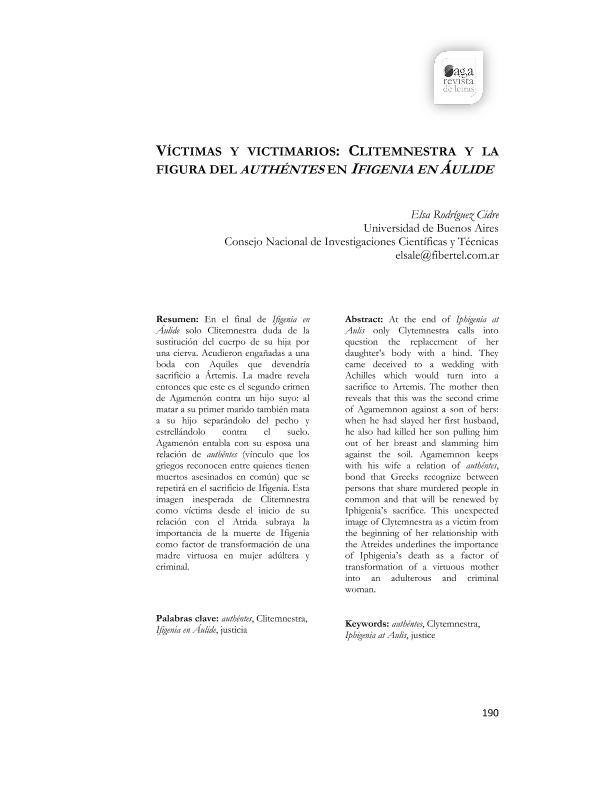Mostrar el registro sencillo del ítem
dc.contributor.author
Rodríguez, Elsa

dc.date.available
2019-11-28T15:00:01Z
dc.date.issued
2016-03
dc.identifier.citation
Rodríguez, Elsa; Víctimas y victimarios: Clitemnestra y la figura del authéntes en Ifigenia en Áulide; Universidad Nacional de Rosario. Facultad de Humanidades y Artes. Escuela de Letras; Saga.; 5; 3-2016; 190-210
dc.identifier.issn
2408-4409
dc.identifier.uri
http://hdl.handle.net/11336/90766
dc.description.abstract
En el final de Ifigenia en Áulide solo Clitemnestra duda de la sustitución del cuerpo de su hija por una cierva. Acudieron engañadas a una boda con Aquiles que devendría sacrificio a Ártemis. La madre revela entonces que este es el segundo crimen de Agamenón contra un hijo suyo: al matar a su primer marido también mata a su hijo separándolo del pecho y estrellándolo contra el suelo. Agamenón entabla con su esposa una relación de authéntes (vínculo que los griegos reconocen entre quienes tienen muertos asesinados en común) que se repetirá en el sacrificio de Ifigenia. Esta imagen inesperada de Clitemnestra como víctima desde el inicio de su relación con el Atrida subraya la importancia de la muerte de Ifigenia como factor de transformación de una madre virtuosa en mujer adúltera y criminal.
dc.description.abstract
At the end of Iphigenia at Aulis only Clytemnestra calls into question the replacement of her daughter’s body with a hind. They came deceived to a wedding with Achilles which would turn into a sacrifice to Artemis. The mother then reveals that this was the second crime of Agamemnon against a son of hers: when he had slayed her first husband, he also had killed her son pulling him out of her breast and slamming him against the soil. Agamemnon keeps with his wife a relation of authéntes, bond that Greeks recognize between persons that share murdered people in common and that will be renewed by Iphigenia’s sacrifice. This unexpected image of Clytemnestra as a victim from the beginning of her relationship with the Atreides underlines the importance of Iphigenia’s death as a factor of transformation of a virtuous mother into an adulterous and criminal woman.
dc.format
application/pdf
dc.language.iso
spa
dc.publisher
Universidad Nacional de Rosario. Facultad de Humanidades y Artes. Escuela de Letras
dc.rights
info:eu-repo/semantics/openAccess
dc.rights.uri
https://creativecommons.org/licenses/by-nc-sa/2.5/ar/
dc.subject
AUTHÉNTES
dc.subject
CLITEMNESTRA
dc.subject
IFIGENIA EN ÁULIDE
dc.subject
JUSTICIA
dc.subject.classification
Otras Lengua y Literatura

dc.subject.classification
Lengua y Literatura

dc.subject.classification
HUMANIDADES

dc.title
Víctimas y victimarios: Clitemnestra y la figura del authéntes en Ifigenia en Áulide
dc.type
info:eu-repo/semantics/article
dc.type
info:ar-repo/semantics/artículo
dc.type
info:eu-repo/semantics/publishedVersion
dc.date.updated
2019-11-15T15:31:38Z
dc.journal.volume
5
dc.journal.pagination
190-210
dc.journal.pais
Argentina

dc.journal.ciudad
Rosario
dc.description.fil
Fil: Rodríguez, Elsa. Consejo Nacional de Investigaciones Científicas y Técnicas; Argentina. Universidad de Buenos Aires. Facultad de Filosofía y Letras. Instituto de Filología Clásica; Argentina
dc.journal.title
Saga.
dc.relation.alternativeid
info:eu-repo/semantics/altIdentifier/url/http://sagarevistadeletras.com.ar/archivos/6.-RODR%C3%8DGUEZ-CIDRE.pdf
Archivos asociados
